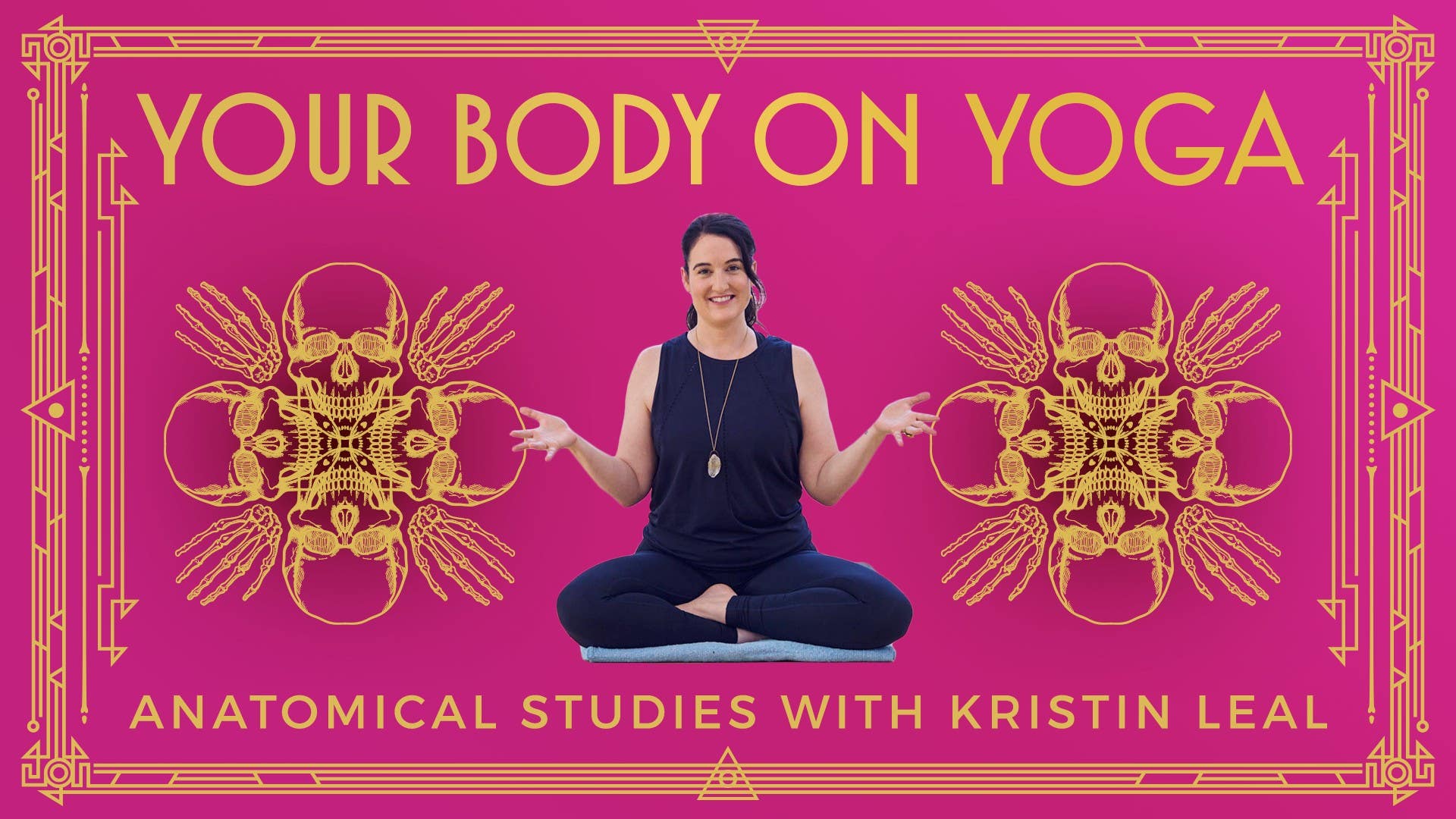Description
About This Video
Transcript
Read Full Transcript
Chapter 1
Proportion of the humerus to the head and neck.
I am so honored to have the Yoga Anytime All Stars here to join us to show some differences in our own bodies, in our own skeletons. I think as yoga teachers, as anatomy people, we're interested in looking at the skeletons and anatomy in textbooks and like to learn how everything fits together. But then when we see ourselves in these movements, when we see our students in these movements, we go, whoa, what's happening? Everyone is so gosh darn different. So I'd like to give you some examples.
We're not just different where we come from, our constitution, our fleshy body is going to show up differently, but on the basic level of our skeleton, we are wildly unique. So our proportions sometimes can be different. So I'm going to ask you guys to lift your arms up towards the ceiling, just like normal human arms, and then bend your elbows and just take your hands behind your head, almost like you're doing headstand on the ceiling. And the forearm is just about parallel to the ceiling. Yeah, perfect.
Beautiful, guys. So I want you to take a look at there's a different showing of the proportion between the humerus and the head and neck. So Linda is showing this amazing shape and her, if I were the floor, my head and arms or Linda's head and arms would be touching down the same amount, it would be flush to the floor. Now Alana here is showing her equally beautiful posture. When she's doing headstand, her head is touching the floor and she has a little space between the floor and her forearms.
Now Heath is showing a long humerus to head and neck proportion. Again, head is pretty flush with the forearms. And then we have Rosemary, who has it just slightly below her head. There's a little bit of space. We're all in the spectrum.
Now these are all yoga teachers, so it's a bit of a skewed sample group. They enjoyed yoga enough and they weren't tortured by headstand enough that they stuck with it and became educators of this practice. So your proportion may be wildly different. Check it out in the mirror at home and let me know what's going on because who's always going to have more weight on their head, Miss Alana. So even if everything was equally aligned, right?
So you had Bandhas up the wazoo, perfectly aligned headstand posture, just textbook beautiful headstands. Alana will always have a little bit more weight on her head than say Linda or Heath or Rosemary. Doesn't mean that she can't enjoy headstand, but she might have to look at how to support it differently or adapt it or maybe choose if maybe she wants to let that posture go for the safety of her poor beautiful neck vertebra. We're going to take a look at some other proportions next. Thank you guys.
Chapter 2
Proportion of the arms to the torso.
Another thing we can look at is the proportion of our arms to our torso. So let's all take the arms down by the sides and just extend through the wrist, almost like you're going to play patty cake with the floor. So just normal human shoulders, not super yogis, and then just extending through the wrist. Now, if you look, some of us have our hands closer or further away from the floor. This has nothing to do with how amazing you are at yoga or how wonderful you are as a person.
This is just the normal variants of anatomy in our skeletons. So if you see here, our kind of two biggest examples of this might be Alana and Rosemary. So Alana's hands are a little bit further away from the floor than Rosemary's, a little bit longer arms to her torso proportion, a little bit shorter arms to her torso proportion for Alana here. So who's going to have an easier time, again, if all things were equal, doing some kind of hopping forward or stepping forward to the front of the mat or something like tolasno or lowlasno, where you're picking yourself up off the floor? Yeah.
Rosemary. And it doesn't mean she's a better yogi necessarily, but it comes more naturally because of her unique body proportions. So if someone with a shorter arm to torso portion really felt compelled to do those moves or you're hopping through to sit or you're pushing up away from the floor and it was a value, maybe taking adaptations of putting your hands on blocks, I call them arm extenders to just give you a little bit more of a boost. And then in another episode, we're going to look at some more body proportions.
Chapter 3
Proportion of the femur to the torso.
Another proportion that we can check out is our femur thigh bone to torso proportion.
So I'm going to have you all bend one knee into your chest, you can help it kind of step the foot to the floor and just leverage yourself up as tall as possible. And then take your arm forward and bring your arm bone just about parallel to the floor. Wonderful. All right. So we're just using the arm as a marker as to where the top of the torso stops.
So if you notice, some of us will have a little bit of space between the knee and the arm, like Rosemary and Linda have a little bit of space between their arm and knee. We look at Heath though, his knee and his arm are on kind of the same plane, the same level, different femur to torso proportion. And if we look at Alana, there's more space between her knee and the top of her arm. So this makes a big difference if you're doing things like binding. So if you were to take like an extended side angle and try to bind or a seated spinal twist and try to bind, some of us will have to kind of shrink down, wrap under, and then your teacher's going to say things like lengthen your spine, open your chest, expand, and then you're going to have to provide all of this compressive force to get to breathe, to be in that posture.
Some of us with a longer femur to torso proportion might just be able to slip their arms underneath, not have to sacrifice any length in their spine or their breath, and just be a little bit more easeful in that pose. And it doesn't mean that if we wanted to take a bind and binds were important to us, we could find some way to do it that doesn't sacrifice our bodies. Or we might choose that, you know, why tie ourselves up in knots if we don't have to.
Chapter 4
Differences between inner elbows.
A very common cue in downward facing dog, or really anytime we have our hands supporting weight on the floor, are things like spin the inner eyes of your elbows forward or towards one another, all sorts of wild things we're asking to do with our own elbows. What I'd like to show you is that everyone's elbows are really wildly different.
So first things first, we're going to look at what's called the carrying angle. So I'm going to have you guys take your arms forward, almost like you're playing volleyball. And then take the palms facing forward, and then just tip down a little bit so people can see the angle between the inner wrist and the inner armpit. Some of us have what's considered more classically an android skeleton or closer to the male end of the spectrum in the skeleton, what's called a wider carrying angle. So if you look at Perry, you can see this kind of triangle shape in between his arms.
Closer to the gynecoid skeleton or the female skeleton, what shows up more typically is what's called a narrow carrying angle. So you can see here on Rosemary, very classic, narrow carrying angle example, her inner wrists, her inner forearms, even her inner elbows are touching. And then this rule doesn't always apply, because if you look at Heath, an android skeleton, he has a more narrow carrying angle. And if you look at Linda here, we can see a little bit wider carrying angle. So the rules, even in anatomy, can get all shaken up.
So this might be one of the reasons why the adjustments or verbal cues that we're giving to people's inner elbows can be reassessed or relooked at to see when and when it's not appropriate.
Chapter 5
Amount of extension and flexion in the joints.
We can also see a difference in the amount of extension or flexion in each and every joint. So let's use the elbow for example. So let's take the arm out to the side and just fully extend to whatever you comfortably can fully extend to. Now you can see that what is considered normal or average in the anatomy textbook is being able to extend about 180 degrees between the forearm bones and the humerus at the elbow joint.
Now what you can see though is that we're all, again, wildly different. Some of us have that kind of showing up of 180, and Linda actually has slightly less of that, a little bit more acute angle. And if we look at Rosemary though, she has a hyper extension in her elbow. And I think I even beat her with my ability, my special ability to hyper extend my elbows. Don't be jealous.
So and then we look at Heath and we look at Alana. They're really showing kind of the classic 180, Alana may be a teeny bit hyper extended in her elbows. So really wildly different. Why don't you guys lower your arms so you don't hate me after this. So this is going to, again, make a difference.
We all show up differently. We have not just muscular differences, some hyper contracted, some hyper mobile, but even in our own skeletons, depending on how those little processes and dips in the bones fit together, we might have a different range of movement.
Chapter 6
Depending on how the lumps and bumps of our skeleton are fitting together, we might start to look like we have more mobility or less mobility in all of our joints. So let's take a look at Rosemary and Perry in an example like downward facing dog. And we'll just do it in a standing version.So I'm going to have you kind of give me your arms if you would. And then we'll externally rotate the arms and I'm going to walk a little bit back and we're going to pretend like she's coming into kind of a downward facing dog. Now if you notice, she can really go crazy, like down dog gone wild, right? So it might be that she has the projections of her bones just slightly different than someone else. I'm going to ask her very carefully to come back up.
Thank you. But the issue becomes sometimes we hammock into our flexibility, whether it's muscular or something that the skeleton is allowing, and we just kind of just hang into it like a hammock, which might cause some issues to develop in the joints, right? Let's look at Perry, different skeleton, different body. So I'm going to have him give me his arms and then we're going to do a little partner down dog. And then you can bend your knees just so we have kind of a little example.
And if you notice, there's a stopping point. It's not going to go any further, right? He might be built differently, muscularly or skeletonly than Rosemary, right? And they'll have you come up carefully, right? So the poses are going to show up very, very differently.
We're all incredibly unique. There's no such thing as like a cookie cutter posture. And this is something we can keep in mind as we move through the practice.
Your Body on Yoga: Introduction to Anatomy
Comments
Teachers and self-study
time and patience
and a whole lotta tenderness:)
You need to be a subscriber to post a comment.
Please Log In or Create an Account to start your free trial.















